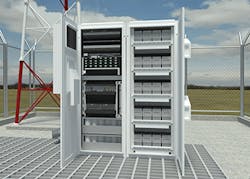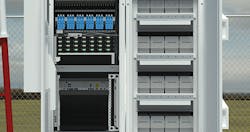The Power-Space Paradox at 5G Cell Sites
The evolution of cellular network architectures toward 5G has followed a long, winding path with occasional detours that met immediate needs and later were incorporated into the evolving big picture. The move from D-RAN to C-RAN architectures is a good example. C-RAN architectures made perfect sense for 4G LTE, and now those sites are being appropriated to support today’s early 5G networks.
We wrote about this in 2018, so I won’t go into great detail here, but C-RAN moved computing resources away from individual cell towers to separate computing hubs supporting multiple towers. This was smart; it consolidated IT resources to make them more efficient, more secure, and easier to service. It also was sufficient for the applications 4G LTE enables: heavy on mobile video, with latency an important but not critical factor. (Note: To read the 2018 article, "C-RAN . . . But to Where?", by Jim Wiemer, ISE magazine, March 2018, please visit https://isemag.com/2018/03/c-ran-but-to-where/.)
5G is a different animal altogether, a dramatic upgrade to the network specifically designed to support and enable advanced, ultra-low-latency applications related to the Internet of Things (IoT). 5G eventually will enable significant advances and innovations in everything from telemedicine to autonomous automobiles, but it requires powerful computing at every cell site and network densification far beyond what we see today. It’s not exactly the C-RAN model, but providers are finding those C-RAN hubs are acting as a nice intermediate step in the move toward fully-formed 5G networks.
InvisiLight® Solution for Deploying Fiber
April 2, 2022Go to Market Faster. Speed up Network Deployment
April 2, 2022Episode 10: Fiber Optic Closure Specs Explained…
April 1, 2022Food for Thought from Our 2022 ICT Visionaries
April 1, 2022So, it’s complicated. And that was true even before a global pandemic increased some bandwidth demands by 75% virtually overnight. Before COVID-19, service providers were locked in a frantic race to be the first to widely deploy 5G networks. How frantic? According to IHS Markit, 5G is expected to generate some $12.3 trillion in annual revenue by 2035, so the answer to that question is very. And yet, almost impossibly, the coronavirus amped up the urgency even more as an entire planet started working remotely and stressing networks in new and unexpected ways.
Delivering on that demand is a challenge considering the pandemic’s effects on the global supply chain, but providers seem determined to press forward and even accelerate their 5G rollouts. Before COVID-19, Verizon estimated half the country would have access to 5G by the end of 2020, and our own industry survey conducted with 451 Research found that 86% of wireless operators expect to be delivering 5G services by 2021.
Early deployments will target urban areas, addressing the bandwidth issues inherent in densely populated environments, but that presents other challenges for providers.
Standard power and battery infrastructure at base of cell tower.
Close-up of power and battery enclosures with power conversion devices added to existing DC distribution panel.
The Power-Space Conundrum
We tend to talk about 5G in certainties that do not actually exist. Different providers are defining 5G in different ways, and the vision for the ultimate architecture remains fuzzy. So, let’s look at the things we can say definitively about 5G, starting with this: 5G networks almost certainly will require more power and subsequent cooling. In our survey, 94% said 5G will increase their overall energy costs, and they already are employing or investigating various strategies to reduce energy consumption and costs.
The other thing we know to a virtual certainty is that 5G networks will require more cell sites and denser networks. These networks are designed to deliver micro-edge computing services with near-zero latency. An autonomous vehicle, for example, can’t wait for data to bounce to a data center — or even a cell tower 2-3 miles away — before reacting to a child darting into the road. That kind of real-time data processing and transmission requires computing near the user all the time, and that is exactly what 5G promises to deliver.
That kind of network density requires real estate, and real estate in those high-priority urban areas is at a premium. Providers will look to rooftops, light posts, and the like, to place their 5G equipment, including antennas and remote radio heads. The goals are to make them pervasive yet unobtrusive, and manage costs as much as possible. The smaller the footprint, the better.
So, we know there will be more sites, they will be smaller, and each site will require more power than traditional 4G LTE. Those realities are conspiring to create specific challenges for providers rolling out their 5G networks.
Here’s one example: The typical power systems supporting the radios at the tops of cell towers are underpowered for the job of providing adequate backup to 5G radios that lose utility power. The reason? The power losses between the radio and the DC power system.
Those voltage drops can trigger a shutdown of the remote radio head before the backup battery fully discharges. In the past, with 4G and earlier network architectures, minor voltage drops have been manageable from the base to the radio at the top of the tower, but the increased power demands of 5G are creating a need to boost voltages to ensure sustained cell site operation. That need spawned a wave of power-boosting technologies, but that’s where the other half of this conspiracy comes into play. The small footprint of these sites, especially in urban settings, can make it difficult to add equipment at the base of the tower.
Put another way: 5G microsites need additional equipment at the base of the tower to provide local compute plus adequate power to the radios at the top of the tower, but finding room for that equipment can be a challenge.
The issue is driving some creative industry responses. At Vertiv, we introduced a device that boosts voltage while plugging into an existing DC distribution panel in the same position as a single-pole bullet circuit breaker. It helps enable the necessary power to reach the radio but consumes no additional space at the base. Other equipment providers are taking different approaches, proving necessity remains the mother of invention. It’s certainly not unsolvable and ultimately may prove to be little more than a speed bump on the road to 5G, but it’s an example of the challenges involved when you try to pack more power in a smaller space.
Bottom line: The road to 5G is twisted and bumpy, but it’s also inevitable and increasingly without speed limits. The global pandemic has introduced new challenges and considerations while ramping up the urgency around 5G deployment. Providers who can solve the local compute/high-power/small-space conundrum will inch ahead in the race to deploy these networks and meet the pressing global need.
Like this Article?
Subscribe to ISE magazine and start receiving your FREE monthly copy today!
Resources
https://isemag.com/2018/03/c-ran-but-to-where/
https://cdn.ihs.com/www/pdf/IHS-Technology-5G-Economic-Impact-Study.pdf
About the Author







